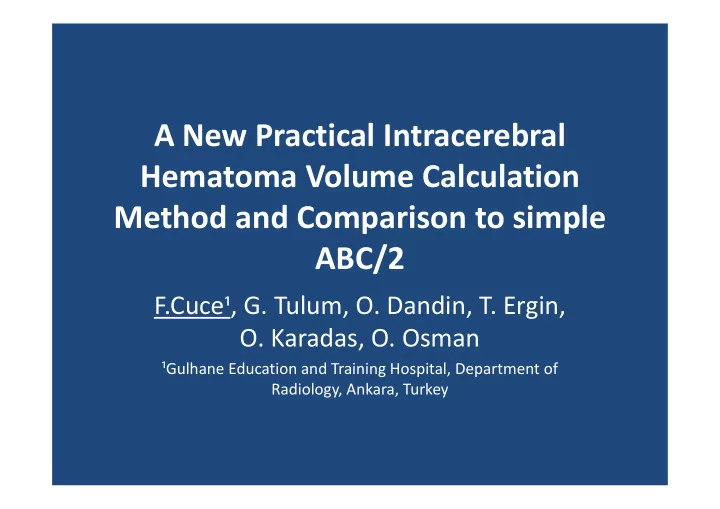

A New Practical Intracerebral Hematoma Volume Calculation Method and Comparison to simple ABC/2 F.Cuce ¹ , G. Tulum, O. Dandin, T. Ergin, O. Karadas, O. Osman ¹Gulhane Education and Training Hospital, Department of Radiology, Ankara, Turkey
Introduction • Intracerebral Hemorrhage Scoring (ICH) is used to predict morbidity and mortality in the cerebral hematoma. • Surgical indication in the MISTIE-III protocol.
• The accurate and timely calculation of brain hematoma volume is important. • The most common and practical formula frequently used is simple ABC / 2 (sABC / 2). • The planimetric method is the gold standard, but in practice, it is not yet available. • Our study is about the use of ABC / 2, and developing a more effective formula.
Subjects and methods • We reviewed the records of 128 patients from January to April 2017. • We only enrolled acute and spontaneous parenchymal and subdural hematomas in our study. (49 patients with 58 hematomas were enrolled in the study). • We obtained a new formula as V=0.34ABC+10. • Our method, sABC/2 formula were compared with planimetric method (using ManSeg 2.6 software) as a gold standart
Computed Tomography Technique: • All examinations were performed on 64-slice CT scanner. • The scanned objects were also reconstructed in 3.0 mm thick transverse. • Matrix size is 512 x 512.
Hematoma volume calculation • AxBxC/ 2 • Choose the slice where the hematoma is the tickest. • A:maximal anteroposterior diameter • B:hematoma thickness • C:number of slices in which the hematoma is visualized multiplied by the slice thickness
• Determinations of hematoma volume and shape were performed by two radiologists. • The hematoma volumes were both calculated with sABC/2 and the proposed formula by the calculator, and also with the gold standard technique using ManSeg 2.6 software.
Statistical Analysis: • Agreement between planimetry and baABC was evaluated using Bland–Altman plots. Sensitivity, specificity, and AUC were calculated. Root mean square errors of the methods were obtained. • Concordance between planimetry and volumes obtained by other estimation methods were assessed using t-test. • Bland–Altman plots were generated for sABC/2 and baABC methods in comparison to the planimetric method using both original and log transformed units.
Results • All methods were concordant with the planimetric method.
• Variability in the concordance between planimetry and the two methods appeared to increase as volumes increased. • V=0.34ABC+10
• baABC method performs better than sABC/2. • For parenchymal cases, sABC/2 baABC RMSE of all both methods 33.99 25.08 ICH (mL) RMSE of approximately have parenchymal 28.61 28.20 ICH (mL) close error values, RMSE of subdural ICH 37.56 22.43 • But in case of subdural (mL) hematoma, baABC is 15.1 ml better than sABC/2.
• Volume errors of cerebral hematoma for all cases.
• Sensitivity and specificity values were obtained for differentiating a cerebral hematoma volume of > 30 mL. • sABC/2 had a sensitivity of 97 % at a specificity of 96 % and AUC: 0.99, • baABC had a sensitivity of 94 % at a specificity of 92 % and AUC: 0.99.
• Concordance between planimetry, sABC/2 and baABC was all high and all are about 0.90. Method Cerebral 95% CI hematoma sABC/2 0.90 (.84- .94) baABC 0.90 (.84- .94)
Discussion • Interobserver correlation of sABC/2 The high coherence degree (ICC:.96) of sABC/2 amongst the readers from • different departments (Khan et al). The planimetric method correlation was lower for various readers with • little experience in comparison to an experienced single reader (Haitham et al) . The correlation of sABC/2 and planimetric method were found to be high • amongst the readers as 0.91-1.0 between two radiologists (Divani et al). In our study, a high degree of correlation between two radiologists was • obtained (0.98) . Also the degree of correlation between planimetric method, the proposed • formula and sABC/2 were calculated as equal (0.90).
• Parenchymal hematoma errorr rates for sABC/2 • The error rate was 10 % in < 20 ml, 37 % in > 40ml (Haithamın et al). • The error rate of was 9.9 % in < 20 ml, 37.1 % in > 40 ml (Wang et al). • This error rate, which increases parallel to the volume, generally tends to be overestimated. • In our study, planimetry to sABC/2 and baABC ratios were all a bit smaller than 1( 0.98 and 0.96).
• Parenchymal hematoma shape • Erroneous results with regular shape hematoma are by 3.33 ml (9.76 %) and in irregular shaped hematoma 7.19 ml (18.37 %) (Xu X et al). • The over-measured volume by sABC/2 is 32.1 % in an irregularly shaped hematoma (Huttner et al). • In our study, the planimetric correlation of our new formula and sABC/2 in irregularly shaped hematoma (for 10 cases) is by 63 %.
• Subdural hematoma • The correlation with planimetric method was high [average volume is 91.0 ml with the sABC/2 and 82.4 ml with the planimetric method] (Gebel et al). • Sucu et al. found that the correlation of all the five different sABC/2 types which they used at different measurement points was high. • In our study, baABC is 15.1 ml better than sABC/2 in subdural hematomas.
Thank you…
Recommend
More recommend